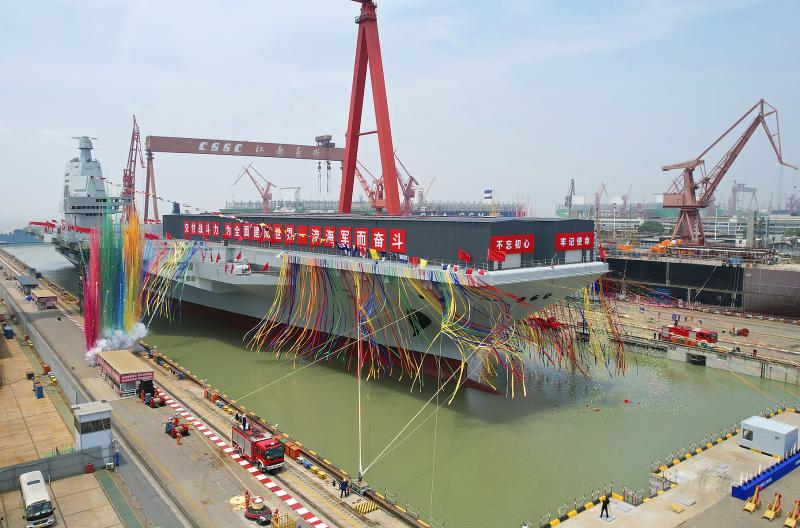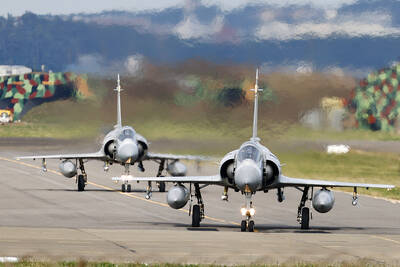Beijing yesterday launched a new-generation aircraft carrier, the first such ship to be designed and built in China, in a milestone as it seeks to extend the range and power of its navy.
The Type 003 carrier christened Fujian left its dry dock at a shipyard outside Shanghai in the morning and tied up at a nearby pier, state media reported.
China Central Television showed assembled navy personnel standing beneath the massive ship as water jets sprayed over its deck, multicolored streamers flew and colored smoke was released.

Photo: AP
Equipped with the latest weaponry and aircraft-launch technology, the ship’s capabilities are thought to rival those of Western carriers, as Beijing seeks to turn its navy, already the world’s largest, into a multi-carrier force.
Satellite imagery captured by Planet Labs PBC on Thursday and analyzed by The Associated Press showed the carrier in what appeared to be a fully flooded dry dock at the Jiangnan Shipyard, near Shanghai, ready for launch. It was draped with red bunting, presumably in preparation for the launch ceremony.
“This is an important milestone for China’s military-industrial complex,” said Ridzwan Rahmat, an analyst with defense intelligence company Janes in Singapore. “This shows that Chinese engineers are now able to indigenously manufacture the full suite of surface combatants associated with modern naval warfare, including corvettes, frigates, destroyers, amphibious assault ships and now an aircraft carrier.”
“This ability to construct a very complex warship from the ground up will inevitably result in various spin-offs and benefits for the Chinese shipbuilding industry,” Rahmat said.
China’s first carrier was a repurposed Soviet ship, and its second was built in China, but based upon a Soviet design. Both were built to employ a so-called “ski-jump” launch method for aircraft, with a ramp at the end of the short runway to help planes take off.
The Type 003 employs a catapult launch, which experts have said appears to be an electromagnetic system, similar to that originally developed by the US Navy.
Xinhua news agency confirmed that the Fujian employed the electromagnetic system in a report on Friday’s launch.
Such a system puts less stress on the aircraft than older steam-type catapult launch systems, and the use of a catapult means that the ship would be able to launch a broader variety of aircraft, which is necessary for China to be able to project naval power at a greater range, Rahmat said.
“These catapults allow aircraft deployed to carry a more extensive load of weapons in addition to external fuel tanks,” Rahmat said.

Taiwan is gearing up to celebrate the New Year at events across the country, headlined by the annual countdown and Taipei 101 fireworks display at midnight. Many of the events are to be livesteamed online. See below for lineups and links: Taipei Taipei’s New Year’s Party 2026 is to begin at 7pm and run until 1am, with the theme “Sailing to the Future.” South Korean girl group KARA is headlining the concert at Taipei City Hall Plaza, with additional performances by Amber An (安心亞), Nick Chou (周湯豪), hip-hop trio Nine One One (玖壹壹), Bii (畢書盡), girl group Genblue (幻藍小熊) and more. The festivities are to

Auckland rang in 2026 with a downtown fireworks display launched from New Zealand’s tallest structure, Sky Tower, making it the first major city to greet the new year at a celebration dampened by rain, while crowds in Taipei braved the elements to watch Taipei 101’s display. South Pacific countries are the first to bid farewell to 2025. Clocks struck midnight in Auckland, with a population of 1.7 million, 18 hours before the famous ball was to drop in New York’s Times Square. The five-minute display involved 3,500 fireworks launched from the 240m Sky Tower. Smaller community events were canceled across New Zealand’s

‘IRRESPONSIBLE’: Beijing’s constant disruption of the ‘status quo’ in the Taiwan Strait has damaged peace, stability and security in the Indo-Pacific region, MOFA said The Presidential Office yesterday condemned China’s launch of another military drill around Taiwan, saying such actions are a “unilateral provocation” that destabilizes regional peace and stability. China should immediately stop the irresponsible and provocative actions, Presidential Office spokeswoman Karen Kuo (郭雅慧) said, after the Chinese People’s Liberation Army (PLA) yesterday announced the start of a new round of joint exercises around Taiwan by the army, navy and air force, which it said were approaching “from different directions.” Code-named “Justice Mission 2025,” the exercises would be conducted in the Taiwan Strait and in areas north, southwest, southeast and east of Taiwan

UNDER WAY: The contract for advanced sensor systems would be fulfilled in Florida, and is expected to be completed by June 2031, the Pentagon said Lockheed Martin has been given a contract involving foreign military sales to Taiwan to meet what Washington calls “an urgent operational need” of Taiwan’s air force, the Pentagon said on Wednesday. The contract has a ceiling value of US$328.5 million, with US$157.3 million in foreign military sales funds obligated at the time of award, the Pentagon said in a statement. “This contract provides for the procurement and delivery of 55 Infrared Search and Track Legion Enhanced Sensor Pods, processors, pod containers and processor containers required to meet the urgent operational need of the Taiwan air force,” it said. The contract’s work would be